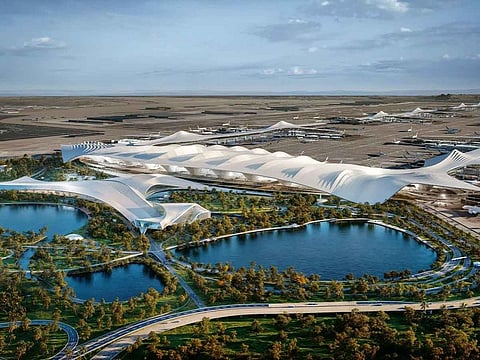Dubai’s new airport: Baggage check-in will be ‘distant memory’, 'blink of an eye’ immigration planned
Vision of DWC is that of a 'contactless airport', says Dubai Airports CEO Paul Griffiths

Dubai: Imagine entering an airport where check-in is a distant memory, baggage vanishes seamlessly upon arrival, and security and immigration are navigated in the blink of an eye. According to Dubai Airports CEO Paul Griffiths, this is the revolutionary vision for Dubai’s aviation future, especially at the proposed $35 billion passenger terminal at Al Maktoum International, also known as Dubai World Central (DWC).
Griffiths and Issam Kazim, the CEO of Dubai Corporation for Tourism and Commerce Marketing, offered a compelling glimpse into Dubai’s trajectory over the next ten years at Dubai Airports’ Learning at Work Week 2025 event.
Running from May 12-16 in alignment with the Global Learning at Work Week, the event brings together industry experts, guest speakers, and employees from across the organisation to exchange insights and explore the evolving landscape of the travel industry.
A key highlight of the week is a fireside chat with Griffiths and Kazim, who shared their vision of Dubai’s future airport and travel sector.
Future of Dubai tourism
Kazim said that the groundwork laid in creating an exceptional living environment for residents is now attracting tourists and ultimately converting them into long-term inhabitants. “Dubai’s growth story is about attracting visitors and becoming the preferred city to live and work in. By opening up as a community and a society to welcome people from all walks of life and create opportunities for them to improve their lives... Dubai truly succeeds,” said Kazim.
He also said that Dubai has become that engine, “that well-oiled machine continuously generating opportunities, chances, and moments, fully capitalising on them and adding further impetus for the future.”
‘Airport of the future’
Griffiths’ vision for the new airport at DWC is one that of a “contactless airport” where the entire journey, from arrival to boarding, is frictionless and invisible. Griffiths said, “Let us eliminate all these 50 to 100-year-old processes that we’ve been practising for far too long and create the world’s first contactless airport.” He also said that streamlining passenger flow would double airport capacity without the immediate need for massive physical expansion.
This plan hinges on the widespread adoption of cutting-edge technologies:
Universal baggage barcoding: Griffiths advocated for embedding barcodes in luggage during manufacturing, allowing seamless tracking and eliminating the need for paper tags and manual handling. Passengers would drop their bags at a designated point, and they would automatically be routed to their destination.
Biometric identification: Replacing traditional passport and boarding pass checks with biometric scanning is central to Griffiths’ vision. He believes facial recognition and other biometric technologies can streamline passenger flow through security, customs, and immigration, making these often stressful processes virtually instantaneous.
Elimination of check-in: With airlines already possessing passenger booking information, Griffiths questioned the necessity of traditional check-in counters. He envisions a system where passengers manage their preferences digitally before arriving at the airport, turning the airport arrival experience into something akin to entering a hotel lobby.
Focus on hospitality: By removing the bottlenecks of traditional airport procedures, Griffiths aims to free up space and time to create a more welcoming and enjoyable environment for travellers. He envisions DWC as a meticulously designed hospitality space, boasting enhanced retail, dining, and lounge options, allowing passengers to relax before their flights.
Integration with ground transportation: Recognising the importance of connectivity beyond the airport, Griffiths stressed the need for robust infrastructure linking DWC with the rest of Dubai. He highlighted the role of a deep-level underground railway in efficiently transporting passengers to and from the new airport, alleviating potential surface traffic congestion. He also lauded the potential of driverless vehicle technology to revolutionise further personal mobility within the city and its connection to the airport.
Sign up for the Daily Briefing
Get the latest news and updates straight to your inbox




